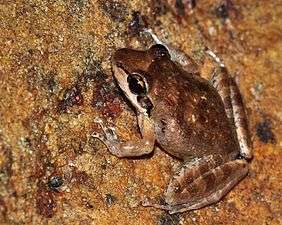Indirana beddomii
Indirana beddomii, Beddome's leaping frog, Beddome's Indian frog, or simply Beddome's frog, is a species of frog found in the Western Ghats.[2] They are usually detected by their long leaps as they flush from the ground when disturbed. The species is named after the naturalist Richard Henry Beddome.
| Indirana beddomii | |
|---|---|
 | |
| Dorsal view | |
| Scientific classification | |
| Kingdom: | Animalia |
| Phylum: | Chordata |
| Class: | Amphibia |
| Order: | Anura |
| Family: | Ranixalidae |
| Genus: | Indirana |
| Species: | I. beddomii |
| Binomial name | |
| Indirana beddomii (Günther, 1876) | |
| Synonyms | |
|
Polypedates beddomii Günther, 1876 | |
Description
Vomerine teeth in two oblique groups are found just behind the level of the choanae. A free, pointed papilla is on the middle of the tongue. The head is moderate, and the snout is obtuse, with an obtuse canthus rostralis and a concave loreal region. The nostril is a little nearer to the end of the snout than to the eye; the interorbital space is as broad as the upper eyelid, or a little narrower; the tympanum is distinct, two-thirds of the diameter of the eye. The front toes are moderate, with the first extending slightly beyond the second; the hind toes are two-thirds webbed, with the web reaching the disks of the third and fifth toes; the tips of the toes are dilated into well-developed disks; the subarticular tubercles are well developed. A single, small, oval inner metatarsal tubercle is present, with no tarsal fold. The tibiotarsal articulation reaches the tip of the snout or a little beyond. The skin of the back has short longitudinal glandular folds, with a strong fold from the eye to the shoulder. Their color is brown above, with rather indistinct darker spots; rarely, they are uniform pinkish, sometimes with a light vertebral band; a dark cross-band occurs between the eyes; a black band is found along the canthus rostralis, and a black temporal spot is seen. Its limbs are more or less distinctly cross-barred; the lower parts are uniformly whitish. Males are without vocal sacs.[3] Their length from snout to vent is about 2.5 in.
Distribution and habitat
This species is found in the forests of the Western Ghats,[2] generally on the ground in moist deciduous and evergreen forests.
References
- Biju, S.D.; Dutta, Sushil; Ravichandran, M.S. (2004). "Indirana beddomii". IUCN Red List of Threatened Species. 2004: e.T58307A11761967. doi:10.2305/IUCN.UK.2004.RLTS.T58307A11761967.en.
- Frost, Darrel R. (2014). "Indirana beddomii (Günther, 1876)". Amphibian Species of the World: an Online Reference. Version 6.0. American Museum of Natural History. Retrieved 31 May 2014.
- Boulenger, G. A. (1890) Fauna of British India. Reptilia and Batrachia
External links
| Wikimedia Commons has media related to Indirana beddomii. |
